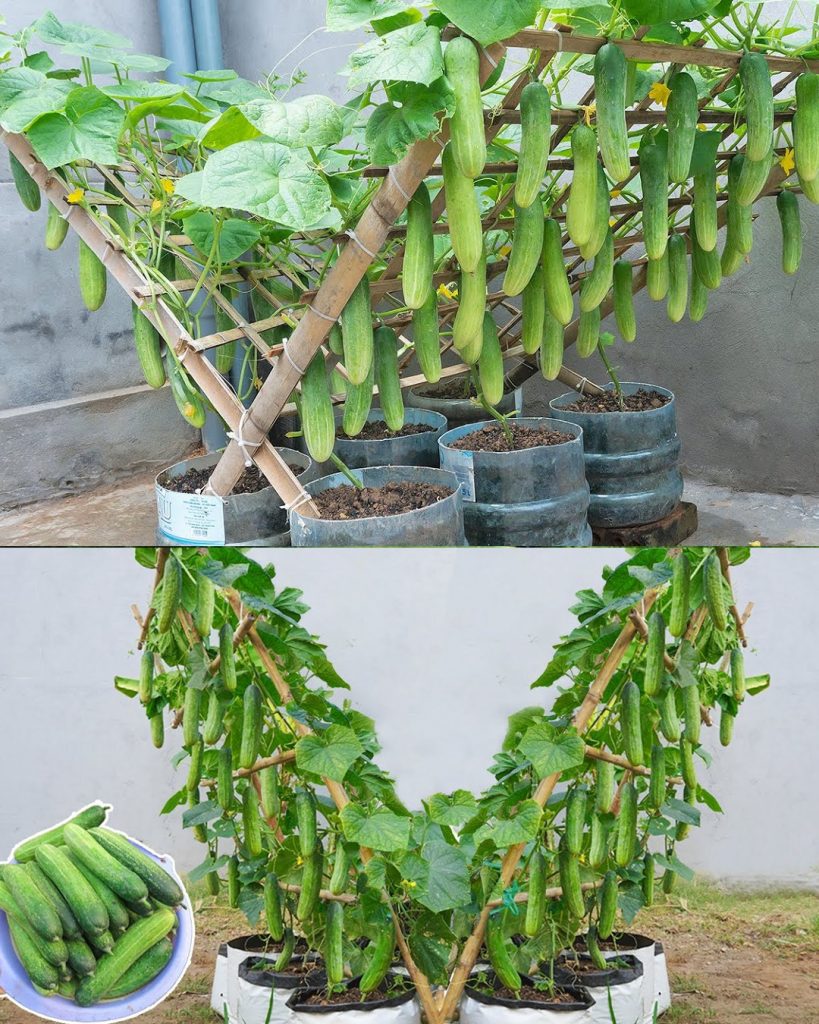Don’t let limited space stand in the way of your green thumb aspirations. If you’re a gardening enthusiast yearning for homegrown produce but have only a modest outdoor area, take heart! Container gardening offers an adaptable solution that enables you to nurture an array of plants, including delightful baby cucumbers, right within the cozy confines of your own home.
In this article, we’ll explore a special technique for growing baby cucumbers in containers, optimizing the potential of your restricted space.
Advantages of Cultivating Baby Cucumbers in Containers:
Container gardening has witnessed a surge in popularity due to its many advantages, particularly for those dealing with spatial constraints. Here’s a rundown of the benefits associated with growing baby cucumbers in containers:
- Efficient Space Use: Containers transform even the tiniest spaces, like balconies, patios, or windowsills, into flourishing grounds for fresh produce.
- Simplified Maintenance: Container gardening streamlines maintenance tasks, making it a breeze to monitor and nurture your plants.
- Pest Resistance: Containers can act as a shield against pests and diseases, as they provide a controlled environment that’s easier to manage.
- Portability: Containers grant you the flexibility to relocate your plants to cater to shifting sunlight and temperature needs, ensuring they thrive under ideal conditions.
- Aesthetic Enhancement: Containers introduce a touch of aesthetics to your living space, elevating its visual appeal with vibrant, green embellishments.

Choosing the Perfect Container:
Selecting the right container is pivotal to your success in cultivating baby cucumbers. Here’s what you should consider:
- Size Matters: Opt for containers with a capacity of at least 5 gallons to accommodate the root system of baby cucumber plants.
- Material Selection: Containers constructed from materials such as plastic, terracotta, or fabric work well. Ensure they come equipped with drainage holes to prevent waterlogging.
- Depth Requirement: Given cucumbers’ deep-rooted nature, opt for containers with ample depth, ideally ranging from 12 to 18 inches.
Setting Up the Container:
Proper preparation lays the groundwork for robust cucumber growth. Follow these essential steps:
- Filling It Right: Load the container with a well-draining potting mix enriched with compost to provide essential nutrients.
- Structural Support: Place a trellis, cage, or vertical support system within the container to offer a framework for the cucumber vines to ascend.
Planting Baby Cucumbers:
The exhilarating moment has arrived – it’s time to plant your baby cucumber seeds or seedlings.
- Spacing Savvy: Plant seeds or seedlings at a minimum distance of 6 inches apart to grant each plant ample room for growth.
- Proper Depth: Seed placement should be around 1 inch deep, adhering to the instructions on the seed packet. For seedlings, ensure they’re positioned at the same depth as in their original pots.
- Watering Wisdom: After planting, irrigate the container thoroughly to maintain uniformly moist soil.
Tending to Baby Cucumbers:
To ensure the prosperity of your baby cucumber plants, adhere to these care guidelines:
- Sunlight Sweetspot: Position the container in an area that basks in at least 6-8 hours of direct sunlight each day.
- Water Wisdom: Keep the soil consistently moist, avoiding waterlogging. Check moisture levels by probing the soil about an inch deep with your finger and water if it feels dry.
- Nutritional Nurturing: Feed your baby cucumber plants a balanced liquid fertilizer every two weeks to stimulate healthy growth. If you want to keep things organic, use a worm compost tea to help fertilize them and improve their resistance to disease .
- Pruning for Prosperity: Remove excess foliage and lateral shoots to divert the plant’s energy toward fruitful cucumber production.
- Pest Vigilance: Routinely inspect your plants for pests and, if any are detected, employ suitable organic pest control techniques.
Harvesting Your Baby Cucumbers:
In approximately 50-70 days, your baby cucumber plants should begin bearing fruit. Harvest cucumbers once they attain the desired size, typically measuring around 3-5 inches. Consistent harvesting encourages the plant to yield more cucumbers.
Embarking on the journey of growing baby cucumbers in containers at home is a fulfilling endeavor, particularly for those working with limited space. Container gardening affords you the pleasure of nurturing your own fresh produce while enhancing the aesthetic charm of your living quarters. With meticulous care and attention, you can relish a bounteous harvest of delectable baby cucumbers, all from the comfort of your compact living space.

